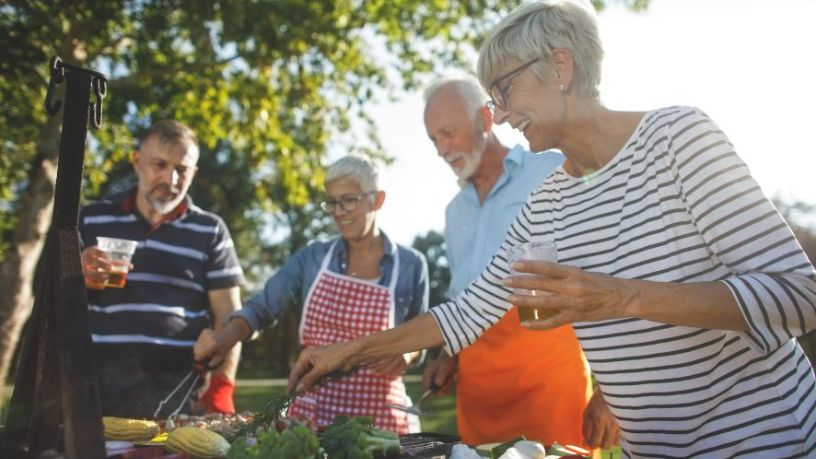Rheumatoid arthritis is a chronic autoimmune disorder that affects thousands of Australians.
On this page
Key takeaways
Symptoms may include stiff and swollen joints.
Learn how to manage rheumatoid arthritis through lifestyle, medication and more.
There are around 456,000 Australians living with rheumatoid arthritis.1 And while it’s most common in older people, this chronic autoimmune condition can affect anyone.
Here, we look at the symptoms, causes and treatment options of rheumatoid arthritis.
What is rheumatoid arthritis?
Rheumatoid arthritis (RA) occurs when your immune system causes inflammation to your joints and surrounding structures.
Your immune system usually fights infections that attack your joints. When this doesn’t work, those affected joins can become inflamed, leading to stiffness, swelling and tenderness.
Eventually, chronic inflammation may lead to a thinning of the cartilage that covers the ends of your bones, which can cause the bone to wear away. It can also irreversibly damage the joint and, in some cases, lead to physical disability.
As well as your joints, RA can affect other parts of your body, including your:
- skin
- lungs
- heart
- eyes.
Symptoms of rheumatoid arthritis
When your body goes to war with its healthy joints, you may initially notice discomfort in areas like your fingers, knuckles, wrists or the balls of your feet. Typically, RA affects both sides at the same time (both hands, both feet).
RA usually develops slowly. But once it takes hold, symptoms can come on quickly and painfully, sometimes making it difficult to carry out everyday activities.
Common RA symptoms include:
- pain and swelling around several joints, making them tender and warm
- stiffness in the morning (or when you sit for a long time) that often lasts longer than 30 minutes
- fatigue
- fever
- weight loss.
RA affects everyone differently, and you may find that your symptoms appear and disappear with minimal pain, swelling or inflammation.
Flares can come on suddenly and last anywhere from days to weeks. While they may occur for no obvious reason, flares are sometimes triggered by things like:
- pushing yourself too hard
- emotional stress
- illness and infection
- skipping medication
- changing your treatment plan.2
Causes of rheumatoid arthritis
The exact cause of RA isn’t fully understood. However, your risk may be influenced by things like:
- genetics
- a family history of the condition
- whether you smoke
- being overweight.
While RA is most common among people aged over 75, it typically sets on between 35 and 64.1
Diagnosing rheumatoid arthritis
If you think you have RA, don’t delay seeing your GP, even if the symptoms are mild. Early diagnosis is key to getting the disease under control.
While there's no single test to diagnose RA, your GP may order one or more of the following:
- a blood test
- an anti-cyclic citrullinated peptide (CCP) antibody test
- an X-ray, ultrasound or MRI (to look for changes in your joints).
Member Health Programs
Discover health cover that's right for you with a range of personalised programs and services designed to support your health and wellbeing.
Rheumatoid arthritis treatment options
While there’s no cure for RA, certain treatment options may help make the condition manageable. These include:
Lifestyle changes
By adjusting your lifestyle and adopting new healthy practices, you may be able to ease your RA symptoms. This might include:
- reducing exertion on your joints. While it's important to exercise, overdoing it can put strain on them
- losing weight. This can help reduce pressure on your joints
- visiting an occupational therapist. They can suggest ways of making everyday tasks easier, and may be able to provide you with specialist equipment
- using hot or cold compression packs. These can help ease pain and relax swollen or tense muscles and joints
- eating a healthy, balanced diet. This should be high in vegetables, fruit and wholegrains, and low in saturated fats, salt and sugar
- quitting smoking. Cigarettes can make symptoms of RA worse
- sleeping better. Stress can trigger symptoms of RA, so reducing it by getting enough quality sleep may help.
- finding complementary therapies. Things like acupuncture and aromatherapy may help relieve RA pain.
Living with RA makes you almost twice as likely to develop heart disease.3 So, things like reducing your saturated fat intake and getting enough regular exercise can help minimise your risk.
Medication
There are numerous medicines to help manage and alleviate symptoms of RA. They include:
- disease-modifying anti-rheumatic drugs (DMARDs). These can slow down the progression of RA and ease symptoms.
- These are often used for short periods to provide symptom relief, especially during a flare-up or when undergoing the initial stages of DMARD therapy.
- Medication such as paracetamol may help relieve pain and stiffness.
- fish oil supplements. Rich in omega-3 fatty acids, these can help manage pain and stiffness.
- non-steroidal anti-inflammatory drugs (NSAIDs). Medicines like ibuprofen can help reduce symptoms of inflammation, relieving pain and swelling.
Surgery
While less common, severely damaged joints that cannot be effectively managed with lifestyle changes and medication may require surgery. Your doctor might recommend one of the following:
- a hip or knee joint replacement
- a synovectomy (to remove the lining of an inflamed joint)
- removing or repairing severely inflamed tendons
- surgery to fuse your bones together
- an osteotomy (to better align or reduce pressure on a joint)
- removing diseased tissue.
Living with rheumatoid arthritis
RA can significantly affect your wellbeing, and it’s not unusual to feel anxious or depressed when living with the condition. It's important to tell your doctor about all of the ways RA impacts your life, including your mental health.
With pain and stiffness comes an increased risk of falls. So, it’s a good idea to think about the things and places in your life that might increase your risk of stumbling, and find solutions and support where needed.
Resources
Arthritis Australia offers support and advice for those living with arthritis. Visit their website or call them on 1800 011 041.
Pain Australia works towards improving the quality of life for those living with pain. Visit their website for resources and support, including their National Pain Services Directory.

At Bupa, trust is everything
Our health and wellbeing information is regularly reviewed and maintained by a team of healthcare experts, to ensure its relevancy and accuracy. Everyone's health journey is unique and health outcomes vary from person to person.
This content is not a replacement for personalised and specific medical, healthcare, or other professional advice. If you have concerns about your health, see your doctor or other health professional.
1Australian Government, Australian Institute of Health and Welfare. (2023). Chronic musculoskeletal conditions: Rheumatoid arthritis. Australian Government, Australian Institute of Health and Welfare.
2Arthritis Australia. (2022). Flares action plan. Arthritis Australia
3Arthritis Foundation. (2022). Rheumatoid Arthritis and Heart Disease. Arthritis Foundation.
You might also like...
Osteoarthritis
The most common arthritis in Australia, osteoarthritis develops over time and can result in painful joints. Find out how this condition might affect you.
What causes osteoporosis and how to lower your risk
Osteoporosis occurs when your bones break down faster than they can repair themselves. Learn the causes, symptoms and treatment options for this common condition.
Top anti-inflammatory foods to help reduce joint pain
Discover some of the best anti-inflammatory foods to relieve joint pain and arthritis. Learn what to eat to support healthier joints and reduce inflammation.
Beware the post hospital blues
It’s common to experience the blues after being in hospital. We explore tips to manage them, what signs to look out for and when to seek help.





